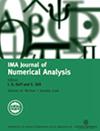基本前-后分裂诱导网络的深层极限与稳定性分析(一):前馈系统
IF 2.4
2区 数学
Q1 MATHEMATICS, APPLIED
引用次数: 0
摘要
前向后向分裂(FBS)是稀疏恢复和图像重建等线性逆问题中最基本、最有效的优化算法之一,近年来被用于构建几种具有显著性能优势的深度神经网络。这种情况促使我们考虑基本fbs诱导网络的一些理论方面。这里的“基本”是指神经网络从原始的FBS算法中展开,直接进行参数松弛。在本文中,我们报告了我们研究的第一部分,即前馈系统的深层极限行为和稳定性。我们将有限层网络表述为差分包含,并将相关的深层极限系统建模为差分包含。我们主要分析了有限层网络到相关的深层极限系统状态的一致收敛性质,以及它们的正向稳定性。我们的分析过程可以简化为分析类LISTA和类alista网络。算例说明了该方法的收敛性和摄动稳定性。作为本研究的副产品,在点向采样和Lipschitz连续性假设的情况下的一些推论提供了数值常微分包含的收敛结果。本文章由计算机程序翻译,如有差异,请以英文原文为准。
Deep-layer limit and stability analysis of the basic forward–backward-splitting induced network (I): feed-forward systems
Forward-backward splitting (FBS) is one of the most fundamental and efficient optimization algorithms in linear inverse problems like sparse recovery and image reconstruction, and has recently been unrolled to construct several deep neural networks with dramatic performance advantages over conventional methods. This circumstance motivates us to consider some theoretical aspects of the basic FBS-induced network. Here, ‘basic’ means that the neural network is unrolled from the original FBS algorithm with direct parameter relaxation. In this paper we report the first part of our study, i.e., deep-layer limit behavior and stability of feed-forward systems. We formulate the finite layer network as a difference inclusion and model the related deep-layer limit system as a differential inclusion. We mainly analyze the uniform convergence properties from the state of the finite layer network to that of the related deep-layer limit system, as well as their forward stability. Our analysis procedure can be simplified to analyze the LISTA- and ALISTA-like networks. A numerical example is implemented to illustrate the convergence results and perturbation stability. As a side product of this study, some corollaries in the case of pointwise sampling and Lipschitz continuity assumptions provide convergence results in the context of numerical ordinary differential inclusion.
求助全文
通过发布文献求助,成功后即可免费获取论文全文。
去求助
来源期刊
CiteScore
5.30
自引率
4.80%
发文量
79
审稿时长
6-12 weeks
期刊介绍:
The IMA Journal of Numerical Analysis (IMAJNA) publishes original contributions to all fields of numerical analysis; articles will be accepted which treat the theory, development or use of practical algorithms and interactions between these aspects. Occasional survey articles are also published.

 求助内容:
求助内容: 应助结果提醒方式:
应助结果提醒方式:


